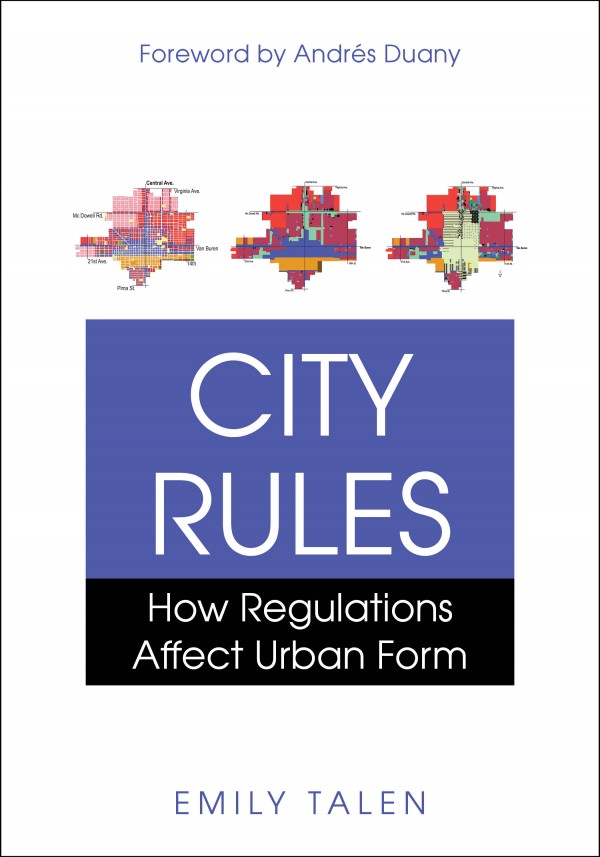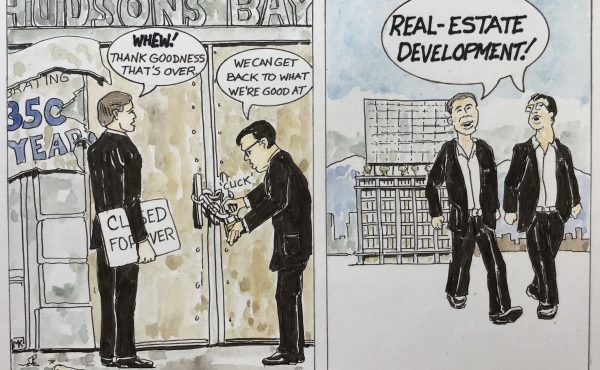
Author: Emily Talen (Island Press, 2011)
American cities are now saddled with rules that work against the formation of compact, diverse, walkable, urban places… In twenty-first century America, there is wide agreement that a new approach to city building is sorely needed. Cities need to be less wasteful and more efficient, less land consumptive and more compact, less dispiriting and more vital. —Emily Talen
Throughout history, we’ve used rules to guide the growth and development of cities, but in the last half-century the connection between the intent of rules and their actual outcomes has broken down. When the first codes were adopted in the 1920s, they were easy to read, with many being under 10 pages long. Early codes struck a balance between mixed uses and moving cars, as well. But over the years, zoning has become more complicated. Cities have kept adding more features—often with a goal of accommodating the automobile. As a result, the original intentions of improving the daily lives of residents was lost. So where did they go wrong?
In City Rules: How Regulations Affect Urban Form, Emily Talen, a professor in the School of Geographical Sciences and Urban Planning and the Director of the Phoenix Urban Research Lab at Arizona State University, explores the irony and contradictions of the rules and regulations that affect urban form. She explores the history of urban regulations and how they have led us to the urban sprawl faced by many cities today. Through highlighting the results of many specific codes, Talen illustrates how even well intentioned rules have resulted in communities unable to meet the changing interests of their residents.
At first glance, this may seem to be a restating of the obvious. By now, most observers of the urban landscape understand that our existing urban form is largely the result of municipal codes. But Talen takes this premise a step further by showing how written codes explicitly affects our everyday lives. For instance, she examines how regulations that were initially intend to improve public health have evolved over time to the point where they now promote development that leads to sedentary lifestyle through a reliance on cars.
Furthermore, Talen explores how the loss of understanding of the effects of existing rules have led to a disconnect between the motivation of the rules and their urban reality. She illustrates how our city rules largely determine not only how and where we live, but also the pollutants we emit, the transportation choices we make, and the urban amenities we enjoy. Through the use of actual examples and visual images (there are 150 colour pictures in the book) she explores many details that are often overlooked by other commentators, such as how curb radii can impact a neighbourhood’s urban form.
But Talen doesn’t want to paint the writers of the original codes with a negatively brush. Indeed, when I talked with her about the book, she noted how much in awe she was of what they accomplished in the 1920s. When Talen started writing the book, she didn’t expect to dig so deep into the history of codes and zoning, but she soon realized that it was important to highlight some of the historical nuances to get a full understanding of how the rules evolved into what we see today.
In the final section of the book, Talen explores ways to reform our current approach to city rules. She explains how by adopting more flexible approaches to regulations—such as form-based codes—cities can begin to reverse the damage caused by many of our existing rule. In doing so, she demonstrates that we can get meaning back into codes and once again use city rules to enhance our communities and create unique and livable spaces.
This, however, won’t be easy. During our conversation, Talen noted that while nobody is satisfied with the status quo, there is no consensus of how to move forward, as there was in the 1920s. In certain planning circles, there remains great resistance to concepts like form-based codes. What is needed, she says, is a greater emphasis on cities that are getting things right through adopting form-based codes or other successful code reform efforts. Perhaps this will help illustrate the way forward and build a consensus for change.
***
Yuri Artibise is a public policy analyst by training and an urbanist by passion. Through his Yurbanism brand, he explores the ‘Y’ of urbanism by sharing ways to make our cities more livable, community-oriented places one block at a time. He currently the Director of Community Engagement with PlaceSpeak, an online location-based community consultation platform.



One comment
Cool. I will have to check this out. A very similar book was written by Jonathan Levine a few years ago called “Zoned Out”.